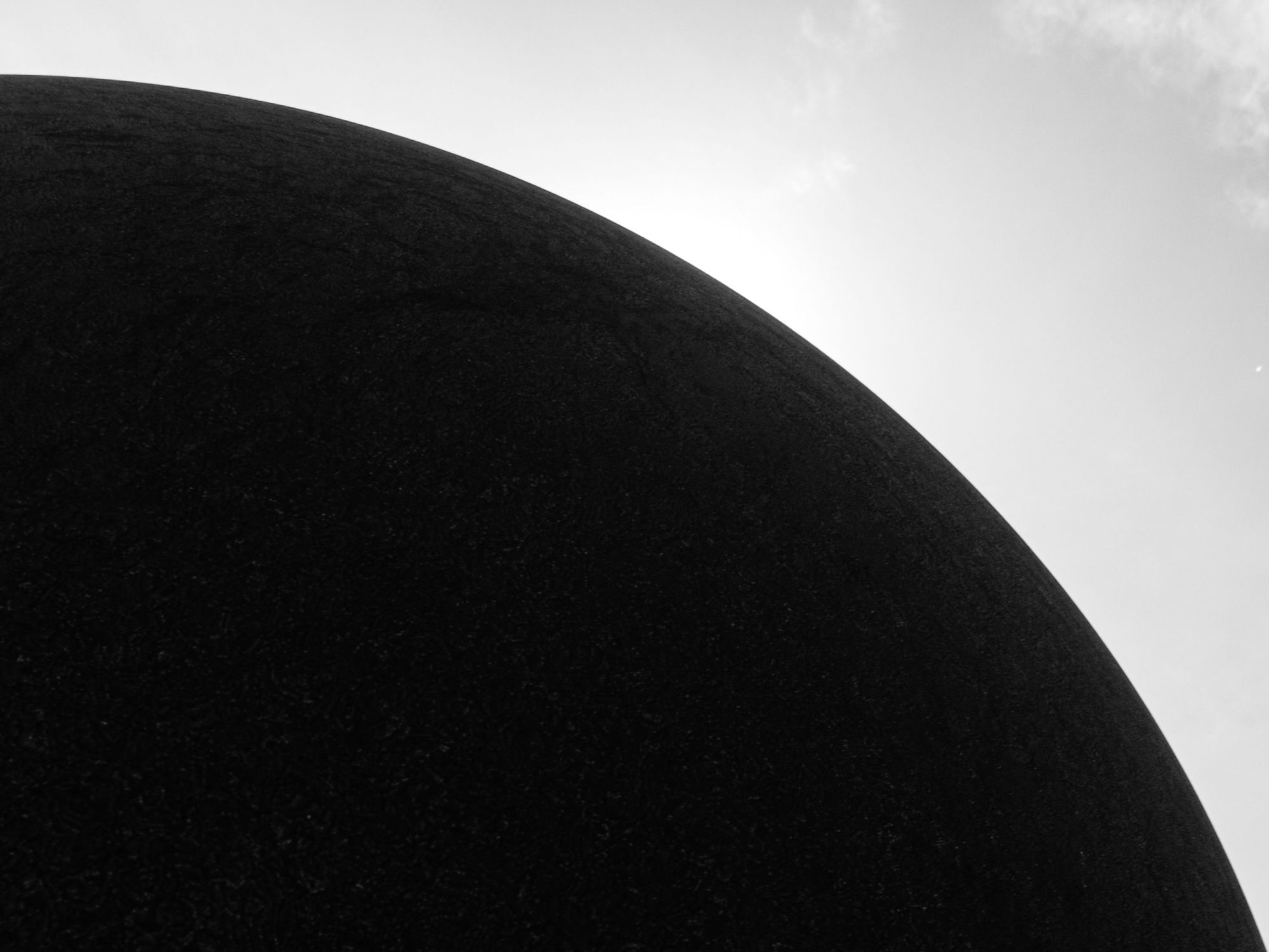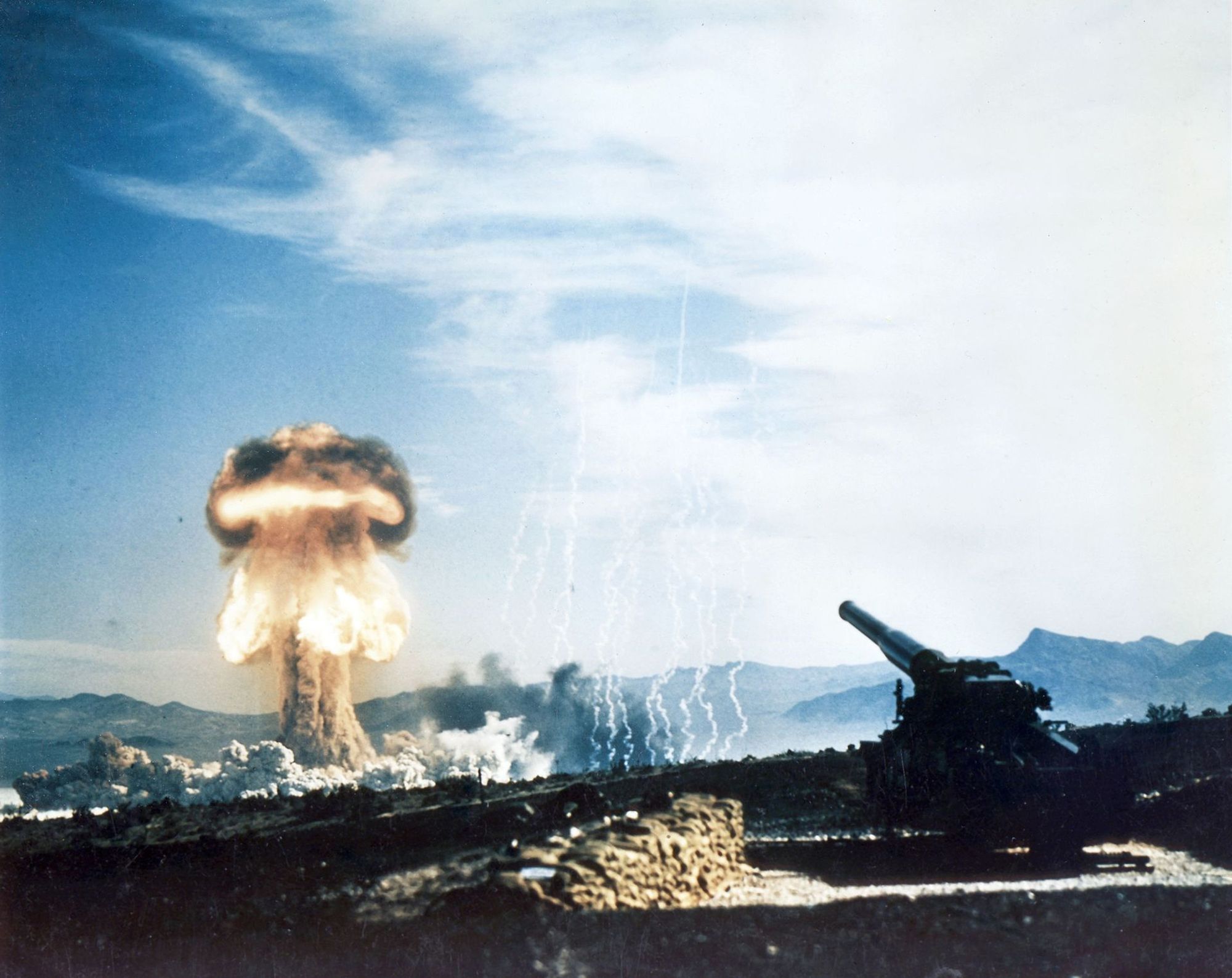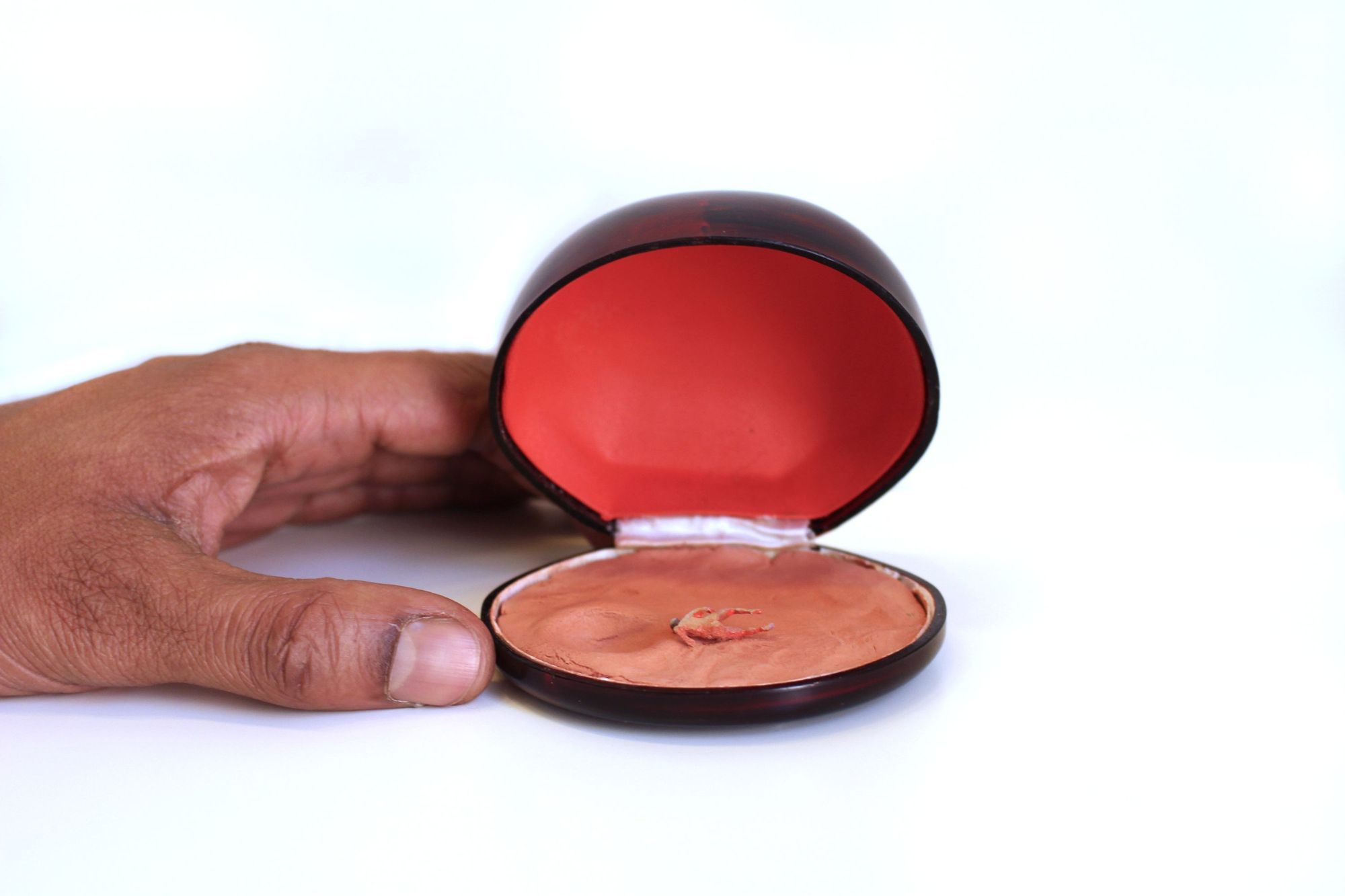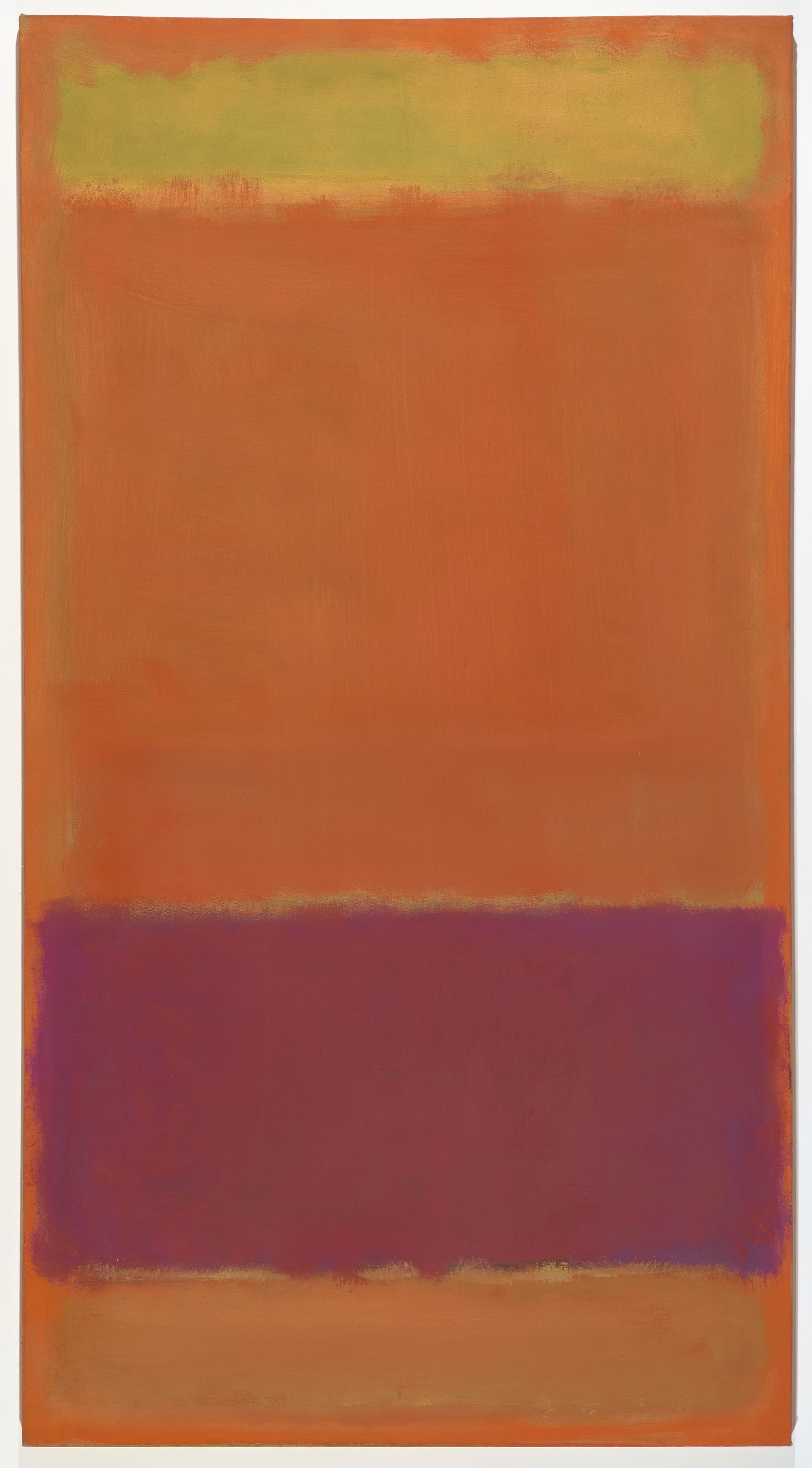Atomic Fireballs: Artists, Activists and the Bomb at 75 (Part I)
This essay is part of the bomb at 75—a virtual experience dedicated to the nuclear destruction of Hiroshima and Nagasaki seventy-five years ago, as well as the existential dangers that we still face today. It is paired with a limited podcast series wherein author Eric Schlosser and artist Smriti Keshari talk with six preeminent experts in the nuclear field about their personal histories, current work, the shocking and fascinating scenes that they have witnessed, and their hope and messages for the future.
On June 12, 1982, more than three-quarters of a million people gathered in Central Park to protest against nuclear weapons. That week, a nuclear war between the United States and the Soviet Union seemed possible. The Soviet invasion of Afghanistan, the election of Ronald Reagan to the presidency, the increased spending on nuclear weapon systems, and the breakdown in diplomacy between the two superpowers inspired worldwide fears of Armageddon. President Reagan opposed arms control agreements and appointed Pentagon officials who believed that a nuclear war could be won. His undersecretary of defense for research and engineering, Thomas K. Jones, suggested that American families would survive if they just dug a hole, covered it with a couple of doors, and put three feet of dirt on top. “It’s the dirt that does it,” Jones explained. “Everyone’s going to make it if there are enough shovels to go around.” Harold Brown, a physicist who’d stepped down as Secretary of Defense in 1981, when Reagan took office, thought a nuclear war between the United States and the Soviet Union would have a somewhat different outcome: More than one hundred million Americans, one hundred million Soviets, and one hundred million people in Western Europe would be killed—within the first half hour.
The protest march began in Midtown, led by hibakushas, survivors of the atomic bombing of Hiroshima and Nagasaki, and a thousand children. It passed the United Nations Building and then headed to Central Park, filling the streets. Linda Rondstadt, James Taylor, Jackson Browne, and Bruce Springsteen performed on the Great Lawn. Orson Welles and Coretta Scott King, the widow of Martin Luther King, gave speeches. The protesters represented a wide variety of groups, including: Social Workers for Nuclear Disarmament, Nurses for a Non-Nuclear Future, the Puerto Rican Socialist Party, the Congressional Black Caucus, and even the Life Insurance Industry Committee for a Nuclear Freeze.
There were also Artists for Nuclear Disarmament. Barbara Kruger created an untitled piece with the phrase “Your manias become science” superimposed over the photograph of a mushroom cloud. Keith Haring, who’d just turned twenty-four, made a poster to commemorate the event. He brought thousands of copies to the demonstration in a shopping cart and handed them out for free. The poster showed his “radiant baby” being swept up in a mushroom cloud, along with other victims of the blast. He later visited Hiroshima and felt deeply affected by what had happened to the first city struck by a nuclear weapon. “It is incredible that this destruction was caused by a bomb that was made in 1945, and that the level of sophistication and number of nuclear weapons has increased since then,” Haring wrote in his journal. “Who could ever want this to happen again? To anyone?”
The anti-nuclear demonstration in Central Park was the largest political protest in American history at the time, bigger than any of the Civil Rights rallies or protests against the Vietnam War. It was also remarkably well-organized. Despite the presence of about 6,000 police officers and almost a million protesters, only one person was arrested, and that was for purse-snatching. A week later, a different sort of nonviolent resistance was orchestrated in midtown Manhattan, as demonstrators blocked the entrances to the UN missions of the five major nuclear powers—the United States, the Soviet Union, China, France, the United Kingdom—and sought to be arrested. The New York City Police Department conducted the largest mass arrest in its history, jailing more than 1,600 protestors. A similar protest blocked the entrance to a California nuclear weapons lab, Lawrence Livermore Laboratory, leading to more than 1,300 arrests.
Within two years of the Central Park demonstration, President Reagan declared in his state of the union address, “A nuclear war cannot be won and must never be fought.” The following year, he said, “We seek the total elimination of nuclear weapons from the face of the earth.” And at the Reykjavik summit in October 1986, he tried but failed to achieve an arms control agreement with the Soviet Union that would’ve abolished the nuclear arsenals of both countries. Reagan’s change-of-heart was sincere, prompted by the influence of his wife, among other things—and the overwhelming public opposition to the nuclear arms race, expressed during massive demonstrations not only in New York but also in London, Bonn, Hamburg, and West Berlin. The Cold War ended peacefully, an unexpected conclusion that seemed almost miraculous. The Soviet Union collapsed in 1991, and the existential threat posed by nuclear weapons was soon forgotten, as a deep, widespread anxiety was swiftly transmuted into historical amnesia. Most people assumed the danger had vanished, along with the Berlin Wall.
Unfortunately, that’s not the case. The risk of a major city being destroyed by a nuclear weapon is probably greater today than at any other time since the destruction of Hiroshima and Nagasaki seventy-five years ago. Nine countries now possess about 14,000 nuclear weapons—and the old bipolar rivalry between the United States and the Soviet Union has been replaced by multipolar rivalries that are far more complex and unstable. Many world leaders still regard these weapons as symbols of national strength and prestige. Every one of the nuclear powers is now modernizing its arsenal—while President Donald Trump pulls the United States out of arms control agreements and sets in motion plans to spend almost $2 trillion on new warheads, bombs, missiles, bombers, and submarines. Extremist groups that celebrate the obliteration of cultural monuments and the mass murder of civilians have expressed the desire to obtain nuclear weapons. And the fact that none of this is being widely discussed, debated, and protested may be the most dangerous thing of all. For almost half a century, artists and activists confronted the nuclear threat, trying to pierce a collective sense of denial. Their efforts are well worth remembering on the 75th anniversary of when Hiroshima and Nagasaki were laid waste. As the world struggles with a terrible pandemic whose impact seemed inconceivable just months ago, we must not forget how a single nuclear detonation can cause more harm in a millisecond.

Leo Szilard was among the first to oppose the use of nuclear weapons. A Hungarian physicist who’d fled Nazi Germany, Szilard was also the person largely responsible for the United States having them. After encountering the description of an “atomic bomb” in The World Set Free (1914), a science fiction novel by H.G. Wells, Szilard brought the idea to Albert Einstein in 1939, worried that the Nazis were attempting to build one. Einstein wrote to President Franklin Roosevelt about the possibility of creating “extremely powerful bombs of a new type”—and the Manhattan Project was soon launched, an enormous, top-secret project to develop an atomic bomb, named after the location of one of its first offices, at 270 Broadway. Szilard played an important role in the project—but as the first test of a nuclear weapon design approached, he began to have doubts. By June 1945, Germany, the intended target of the atomic bomb had already surrendered, and dozens of Japanese cities had been incinerated by American fire bombs. Szilard and a group of fellow scientists formed a Committee on the Social and Political Uses of the Atomic Bomb. It secretly urged the leadership of the Manhattan Project not to allow the use of an atomic bomb against Japan. An uninhabited area would be a much more appropriate target, providing a demonstration of the weapon’s awesome power and encouraging the Japanese to surrender. Szilard warned that dropping the bomb on civilians would unleash a “new means of indiscriminate destruction” and start a nuclear arms race.
A month later, the first nuclear device was tested at the Trinity Site in Alamogordo, New Mexico. Fears that the detonation might set the earth’s atmosphere on fire and kill every living thing on earth proved to be unfounded. “The hills were bathed in brilliant light,” one physicist noted, “as if somebody had turned on the sun with a switch.” Another watched the blast, understood the implications, and said: “Now we are all sons of bitches.” The day after the test, Szilard sent a petition to President Truman, signed by sixty-eight other Manhattan Project scientists, asking him not to use the atomic bomb, warning that it might usher in “an era of devastation on an unimaginable scale” and put American cities in “continuous danger of sudden annihilation.” Despite Szilard’s prominent role in the Manhattan Project, Truman never saw the petition. The top general involved in the project got hold of it and never sent it to the White House.
At eight in the morning on August 6th, 1945, the air wardens in Hiroshima gave the “all clear” signal. An American bombing raid usually involved scores of aircraft flying in formation, and the three planes over the city seemed to be on a harmless reconnaissance mission. People emerged from basements, went outside, returned to their offices. Fifteen minutes later, one of the planes dropped “Little Boy,” the first atomic bomb used in warfare. The bomb detonated at an altitude of about two thousand feet, right over the heart of the city. Temperatures at the point of detonation reached several million degrees Fahrenheit, more than a thousand times hotter than the surface of the sun. A fireball about one-third of a mile wide vaporized everyone directly below, ignited buildings, and started a massive firestorm that destroyed about 90 percent of the structures in Hiroshima. Perhaps 80,000 people, mainly civilians, were killed immediately, or soon after the explosion, by heat, flames, overpressure, flying debris, the collapse of buildings, and ionizing radiation. About half an hour later, a black rain started to fall—a sticky, lethal mixture of soot, water, and two hundred or so radioactive isotopes that poisoned survivors of the initial blast.
Three days later, an even more powerful atomic bomb was dropped on Nagasaki. And on August 14, the emperor of Japan announced an unconditional surrender, overruling many of his generals, who wanted to continue the war against the United States. “The enemy has for the first time used cruel bombs,” the emperor said, “and the heavy casualties are beyond measure.”
After the war, Szilard worked closely with other Manhattan Project scientists to ensure that America’s nuclear weapons remained under civilian, not military control. He spent much of the next two decades supporting arms control efforts, working to reduce the nuclear threat, and promoting world peace. Having co-designed the first nuclear reactor and helped to invent the atomic bomb, Szilard became disillusioned with physics, abandoned the field after the destruction of Hiroshima and Nagasaki, and became an influential molecular biologist. The winners of the Nobel Prize for Medicine or Physiology in 1965 publicly thanked him for providing crucial insights into their research on “genetic control of enzyme and virus synthesis.” Szilard also wrote science fiction, most notably a short story about super-intelligent dolphins who prevent the United States and the Soviet Union from destroying the world.

At first, the American people celebrated the atomic bomb. It was depicted as a technological marvel, the “ultimate weapon” that ended the war without an invasion of Japan, sparing hundreds of thousands, perhaps millions, of lives. Newspaper accounts focused on the power of the atomic bomb, the dramatic story of its development, the global leadership it conferred on the United States. But the feelings of pride and relief were soon tempered by the realization that such bombs might one day be used against the nation that devised them. It would be almost impossible to defend against a nuclear attack. If one hundred enemy planes approached, carrying atomic bombs, you could shoot down ninety-nine of them—but if one plane managed to get through, an entire city would be destroyed. Nuclear weapons mounted on missiles would be even harder to stop. This new technology had made mass murder relatively cheap and easy to achieve. Before long, nobody would be safe. Writing in his journal two days after the destruction of Hiroshima, the French philosopher and novelist Albert Camus observed that “any average-sized town can [now] be completely leveled by a bomb the size of a football.” Humanity faced an existential choice, Camus thought, “between collective suicide or the intelligent utilization of scientific conquests...between hell and reason.”
The first images released from Hiroshima and Nagasaki were heavily censored, depicting the effects of the atomic bomb on buildings, not on human beings. Footage of corpses, burn victims, homeless children, and people suffering from radiation sickness were classified “Top Secret.” The United States Department of War didn’t want any reporting that might raise questions about the decision to drop the atomic bombs or prompt opposition to the development of new ones. During the spring of 1946, William Shawn, the managing editor of The New Yorker, thought the full story had not yet been told. He asked a thirty-one-year-old, John Hersey, to write about the atom bomb’s impact on ordinary people in Hiroshima. Hersey seemed the right person for the job. A graduate of Yale University and Clare College, he’d left the comforts of the literary world for the battlefields of the Second World War. He’d seen fighting in Italy, the Philippines, and the South Pacific. He’d written two books of war reportage and a novel, A Bell for Adano, that won the Pulitzer Prize. In all these works, Hersey displayed a flair for storytelling and an ability to imbue the lives of individuals with the larger social and political themes of the day. For the New Yorker, he spent weeks in the ruins of Tokyo and Hiroshima, gathering information and interviewing survivors of the atomic bomb.
Hersey submitted a 31,000 word manuscript to the magazine, hoping that it might run in three or four parts. Instead, the New Yorker devoted its entire August 31, 1946 issue to the piece, which was entitled “Hiroshima.” It followed the lives of six people—a surgeon, a young widow, a file clerk, the owner of a hospital, a Jesuit priest, a pastor at the Hiroshima Methodist Church—from the moment of the bomb’s detonation through the nightmare of the following year. Without preaching or moralizing, calmly, simply, and in memorable detail, Hersey described what happened to people in Hiroshima. The facts spoke eloquently for themselves. The article caused a sensation, and the issue containing it sold out within hours. “Hiroshima” had both an immediate and a lasting effect, presenting a reality that most people had suspected but had been suppressed. It took the wind out of American triumphalism and inspired sympathy for a former enemy recently despised, ridiculed, and subjected to racism. The full text of the article was read aloud and broadcast on the radio by ABC, the BBC, and networks in Canada and Australia. A few months later, it was published as a book. Hiroshima is full of tragedy and horrifying images—but ultimately life-affirming. It is the beautifully written story of six survivors. I consider it the greatest and most important work of non-fiction ever written.

The publication of Hiroshima heightened the public fears about nuclear weapons. Much of that anxiety was focused on New York City, which had been depicted in newspapers as the site of a future nuclear apocalypse within a day of the Hiroshima bombing. The evening paper PM speculated that City Hall would be ground zero. Reader’s Digest placed the detonation directly above the Empire State Building. Life magazine ran a drawing of the New York Public Library turned to rubble, with only the marble lions surviving the blast. “If the Bomb Gets Out of Hand,” an essay by the Manhattan Project physicist Philip Morrison, published in the book One World or None (1946), described an atom bomb detonating “just above the corner of Third Avenue and East 20th Street, near Gramercy Park.” Many thousands were killed, Bellevue Hospital was destroyed, but the Empire State Building remained “strikingly undamaged.” A short documentary film, also called One World or None (1946), featured an animated sequence of an atomic bomb hitting lower Manhattan. “A flash, a blast, the release of deadly radioactive rays, and in a matter of seconds, downtown New York would be a massive ruin,” the narrator said, followed by a trippy image of a human skull, surrounded by concentric circles of white crosses, imposed on a map of the city.
The most striking images of New York City’s annihilation were created by Chesley Bonestell—better known as the first great space artist, an architect and science fiction illustrator who also helped to design the Chrysler Building and the Golden Gate Bridge. The cover of the August 3, 1950 issue of Collier’s magazine, featured “Atom Bomb Hits New York City,” a Bonestell oil painting of a mushroom cloud rising above Manhattan at night. The cover story was “Hiroshima, U.S.A.: Can Anything be Done About It?” Inside, the magazine included another Bonestell painting, this time an aerial view of Manhattan in flames. He also painted “A-bombing of New York City,” in which both Brooklyn and Manhattan are hit; “The H Bomb Hits Lower New York City,” with luminous clouds that bring to mind the work of Albert Pinkham Ryder; and “The Nation’s Capital After the Atomic Blast,” a variation of the apocalyptic theme, with Washington, D.C., burning.
In addition to being continually destroyed in atomic fictions, New York City emerged after the war as the cutting edge of fine art. Janet Sobel--who pioneered drip painting but was dismissed for being a woman and a housewife--confronted the atomic bomb directly in a swirling, partly figurative vision of Hiroshima (1948).Even the abstract expressionism of the New York School, which rejected the literal portrayal of any social reality, was swayed by the atomic bomb and the existential dread that accompanied it. “We now know the terror to expect,” Barnett Newman wrote in 1948. “Hiroshima showed it to us... and no matter how heroic, or innocent, or moral our individual lives may be, this new fate hangs over us.” Painted the year after Hiroshima, “Pagan Void” (1946) may have, in the words of one critic, been Newman’s attempt to “evoke the biblical account of the earth’s creation.” But it also looks a hell of a lot like the high-speed photos of a nuclear detonation taken a few years later.

Jackson Pollack’s drip paintings are similarly open to multiple interpretations, reflecting his personal moods during their creation. “My opinion is that new needs need new techniques...It seems to me that the modern painter cannot express this age, the airplane, the atom bomb, the radio, in old forms of the Renaissance or any other past culture,” Pollock said in a 1950 interview. “Number 1, 1950 (Lavender Mist)” conveys a dark, fragmented chaos, while “Shimmering Substance” (1946) has a fiery, circular energy in the center of the canvas. Mark Rothko’s color field paintings are considered to be contemplative, nonrepresentational, purely abstract works of art. And yet Rothko expressed a different point-of-view: “I would like to say to those who think of my pictures as serene...that I have imprisoned the most utter violence in every inch of their surface.” In the aftermath of the Holocaust, the firebombing of Dresden, the destruction of Hiroshima and Nagasaki, the disillusionment with communism caused by the Soviet Union’s pact with Nazi Germany, many artists turned away from history and politics and turned inward instead, making paintings about their process and their feelings. And yet unconsciously or just coincidentally, the world still seemed to intrude. Tortured, suicidal, taken with Nietzsche and Greek myths, Rothko couldn’t escape the demons of his age. His painting “Untitled, No. 73” (1952) has all the beauty and serenity of “Ivy Mike,” the first detonation of a hydrogen bomb, which happened to occur that same year, producing a fireball three-and-a-half miles wide.
My grandfather was a muralist, greatly influenced by the work of Diego Rivera and David Siqueiros. He enjoyed success in the 1920s and 1930s, but the triumph of the New York School made his form of social realism and political engagement seem quaintly obsolete. He always used to tell me that abstract expressionism was corporate art, however sincere, rebellious, and well-meaning its creators may have been—that abstract art was championed by the Rockefellers, the Whitneys, and the CIA because it posed no threat to the powers that be. I loved my grandfather dearly but thought his theory was way too paranoid and conspiratorial. Now we know it’s true.
For more reading about the legacy of the atomic bomb, tune into the six-part limited podcast featuring interviews with prominent figures in the nuclear deterrent movement.
Subscribe to Broadcast